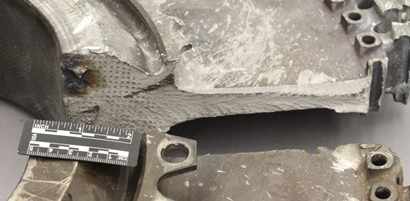NTSB Finds Cracked Disk from Engine After O'Hare Mishap
So far, 3-D imaging of the damage to the right wing has been completed and all members of the cabin crew have been interviewed. The broken disk had 10,984 cycles and had a life limit of 15,000 cycles, according to the board, which said a review of engine maintenance and manufacturing records and processes is ongoing.
The National Transportation Safety Board posted an update Nov. 4 on its investigation of an Oct. 28, 2016, uncontained engine failure on American Airlines flight 383 at Chicago's O'Hare International Airport -- a flight that had Mike Pence, the Republican candidate for vice president in Nov. 8's national election, aboard. The update said a stage 2 high pressure turbine disk in the aircraft's right engine was found to be broken into at least four pieces. The pieces were found in several places, according to a map posted by the board.
Its update said the failure of the GE CF6-80C2B6 engine occurred on as the Boeing 767-300 was making a takeoff roll; the failure occurred at an airspeed of about 128 knots, with the engine operating at takeoff power. About two seconds after the engine failure, at an airspeed of about 134 knots, the left and right engine throttle lever angles decreased rapidly and brake pressure rose in a manner consistent with maximum autobrake application; the auto speedbrakes were extended. The aircraft quickly decelerated and stopped about 25 seconds after the throttle reduction.
An emergency evacuation of the 161 passengers and nine crew members took place as a fuel leak resulted in a pool fire under the right wing. Airport firefighters began applying foam within 2 minutes 51 seconds of being notified of the emergency, according to the board's update.
 Most of the stage 2 disk has been sent to NTSB's laboratory in Washington, D.C., for examination. "One of the fractures exhibited features consistent with fatigue cracking initiating at an internal inclusion near the forward side of the hub's inner bore," it said. "Engine and wing debris were found in the area around the gouge mark on the runway."
Most of the stage 2 disk has been sent to NTSB's laboratory in Washington, D.C., for examination. "One of the fractures exhibited features consistent with fatigue cracking initiating at an internal inclusion near the forward side of the hub's inner bore," it said. "Engine and wing debris were found in the area around the gouge mark on the runway."
So far, 3-D imaging of the damage to the right wing has been completed and all members of the cabin crew have been interviewed. The broken disk had 10,984 cycles and had a life limit of 15,000 cycles, according to the update, which said a review of engine maintenance and manufacturing records and processes is ongoing. The on-scene NTSB team expected to complete its work there over the weekend.